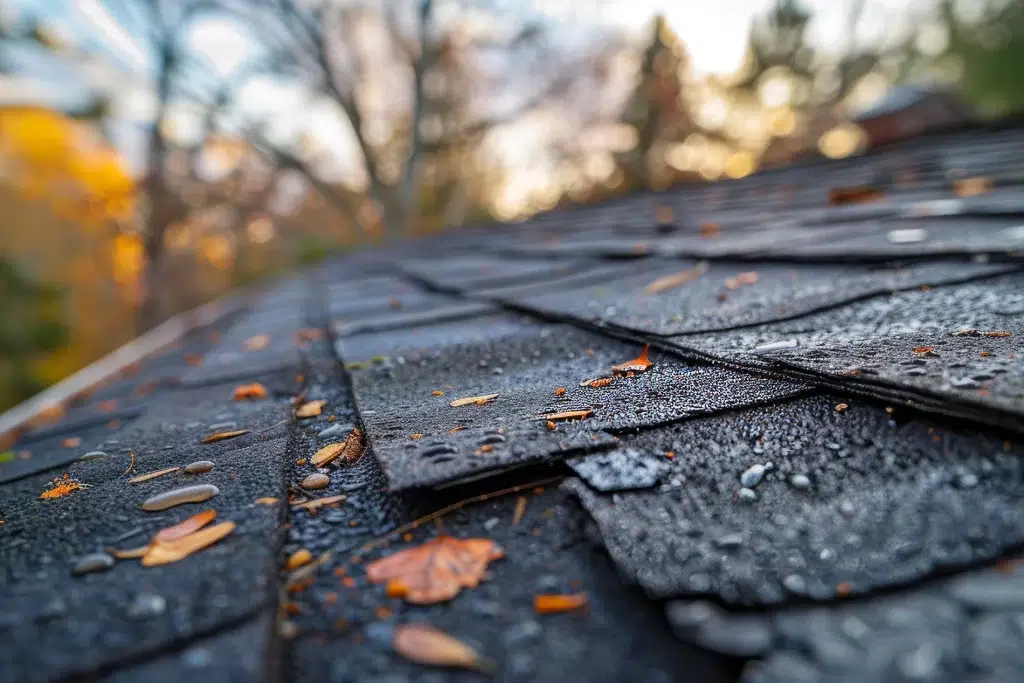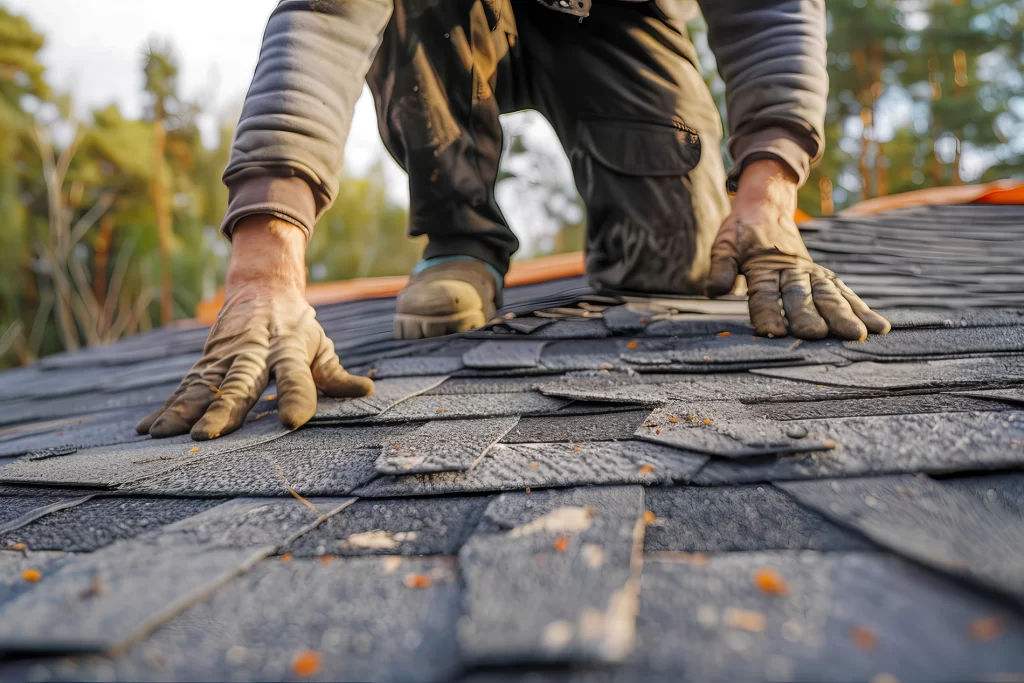A damaged roof can be a homeowner’s nightmare. Understanding how to make a roof insurance claim can save you time, money, and stress. This guide will walk you through the steps you need to take when filing a claim with your insurance company.
Understanding Roof Damage
Hail, wind, and age all play a role in observing for signs of wear and tear on your roof. Recognizing the signs of roof damage early can prevent further issues. Common signs include missing or broken asphalt shingles, dark spots, water stains on your ceiling, and structural damage. Regularly inspect your roof, especially after severe weather, to catch problems early.
Types of Roof Damage
Signs of hail damage include dents and bruises on your shingles, which can lead to water damage if not addressed promptly. Wind damage, strong winds can lift or remove shingles, exposing the underlayment to the elements. With wear and tear over time, roofs age and materials can wither, leading to leaks and other issues.
Steps to Take When You Notice Roof Damage
Regular observation is key after a storm, inspect your roof for any signs of fault. Look for missing shingles, dark spots, and other signs of wear and tear after a weather event.
Proper documentation is crucial for your insurance company to provide coverage. Take photos and videos of your home regularly, and after weather events in case you need them.
The date of loss is also a fact your insurance company will ask for. This documentation will be crucial when filing your insurance claim.


Steps to Take When You Notice Roof Damage
Regular observation is key after a storm, inspect your roof for any signs of fault. Look for missing shingles, dark spots, and other signs of wear and tear after a weather event.
Proper documentation is crucial for your insurance company to provide coverage. Take photos and videos of your home regularly, and after weather events in case you need them.
The date of loss is also a fact your insurance company will ask for. This documentation will be crucial when filing your insurance claim.
Making temporary repairs can be necessary if the damage is severe. If possible, make temporary repairs to prevent further impairment. Cover holes with tarps and secure loose shingles to protect your home from water damage.
Contacting Your Insurance Company: Before You Call
Once you’ve identified and documented the damage, it’s time to contact your insurance company. Review your insurance policy to understand what it covers and what it doesn’t cover. Some policies may not cover certain types of impairment or might have exclusions for wear and tear.
Filing an Insurance Claim
Contact your insurance company to start the claim process. Provide them with the documentation you’ve gathered, including a photo, video, and date of loss. Schedule an inspection, and an insurance adjuster will inspect your roof to assess the damage. Be present during the inspection to emphasize any damage and provide your documentation.
Working with a Roofing Company
Once your claim is approved, there are options you may be presented with. You may receive a check before repairs or after repairs have started. Your insurance company may put you in contact with a roofing company of their choice and have them send the invoice instead.
Choosing your own roofing company may have benefits. Obtain quotes from several roofing companies to ensure you get the best deal. Look for reviews and ask for references from previous clients to ensure the company has a good reputation. If you know someone who is currently replacing their roof, you might ask them about their experience.
Understanding the different roofing materials is crucial. Different roof materials have varying costs and lifespans. Asphalt shingles are common and affordable, but they may not last as long as other materials.
The Roof Replacement Process
Replacing your roof is a significant project that depends on factors such as the size of your roof and the materials used. Here’s what you need to know about the process and timeline.

Timeline: Based on Material and Size
Asphalt shingles are the most common roofing material. Replacing a standard-sized asphalt shingle roof typically takes 1–3 days. Metal roofs can take 2–4 days to install because of the need for precise fitting and additional preparation. Tile roofs are more time-consuming, a tile roof replacement may take 5–7 days because tiles are heavier and require careful placement.
Most homes can expect a 1–5 day period of replacement. Larger homes or roofs with complex designs, such as multiple angles or steep pitches, may take longer. Expect an additional 1–2 days for each complication.

Timeline: Based on Material and Size
Asphalt shingles are the most common roofing material. Replacing a standard-sized asphalt shingle roof typically takes 1–3 days. Metal roofs can take 2–4 days to install because of the need for precise fitting and additional preparation. Tile roofs are more time-consuming, a tile roof replacement may take 5–7 days because tiles are heavier and require careful placement.
Most homes can expect a 1–5 day period of replacement. Larger homes or roofs with complex designs, such as multiple angles or steep pitches, may take longer. Expect an additional 1–2 days for each complication.
Can You Stay In Your Home During Roof Repair?
Although there may be noise and disruption, you can stay in your home during a roof replacement. Replacing a roof involves a lot of hammering and movement. If you work from home or have young children, you might want to consider spending a few days elsewhere.
Ensure your family and pets stay indoors and away from the work area. Contractors will be moving materials and debris, which can pose hazards. There should be no interruption to your utilities, but inform your roofing company of any specific needs or concerns. The most common interruption is a blocked driveway because of debris or building material.
Roof Replacement vs. Repair
Depending on the extent of the damage, you may need to decide between roof replacement and roof repair. Consider the severity of the damage, the age of your roof, and the costs associated with either option.
Inspect the severity of the damage after a weather event. If the damage is severe, replacing your roof might be more cost-effective in the long run. Most insurance companies cover loss caused by sudden or unstoppable forces, such as weather events.
Consider the age of your roof. Older roofs are more prone to withering. If your roof is near the end of its lifespan, replacement might be the better option. Unfortunately, most insurance companies will not cover roofs older than 15–20 years old.
Compare the cost of repairs versus a full replacement. Consider insurance coverage or reimbursements. Sometimes, frequent repairs can compile and become more expensive than replacing the roof entirely.
Preventing Future Damage
Regular Inspections reveal any causes of future damages. Observe your roof at least twice a year and after major storms. Look for signs of damage and address them promptly.
To avoid future roof damage, regular maintenance is key. Gutter maintenance will prevent buildup and any water overflow or leakage.
Gutter maintenance is crucial and easily accessible. Clean your gutters regularly to prevent water from backing up and causing wear and tear to your roof and home. You can grab a ladder and do it yourself, or call a professional. Sometimes you don’t even need a professional, as kids in every neighborhood provide gutter maintenance cheaply.
Regular maintenance of the vegetation around your house, such as trees can prevent loss from fallen tree limbs. Maintaining the trees around your house can also prevent critters from nesting or damaging your roof.
Simplifying the Roof Insurance Claims Process
Dealing with roof damage can be stressful, but knowing how to handle roof insurance claims can make the process smoother. Review your insurance policy, document any damage, and choose a reputable roofing company. These steps ensure efficient roof repair or replacement. Regular maintenance and inspections will help prevent future issues, keeping your home safe and secure.
If you suspect roof damage, don’t wait, check your roof, document the damage, and contact your insurance company to start the claims process. These steps will help you through the complex roof insurance claims process and protect your home from further damage.


